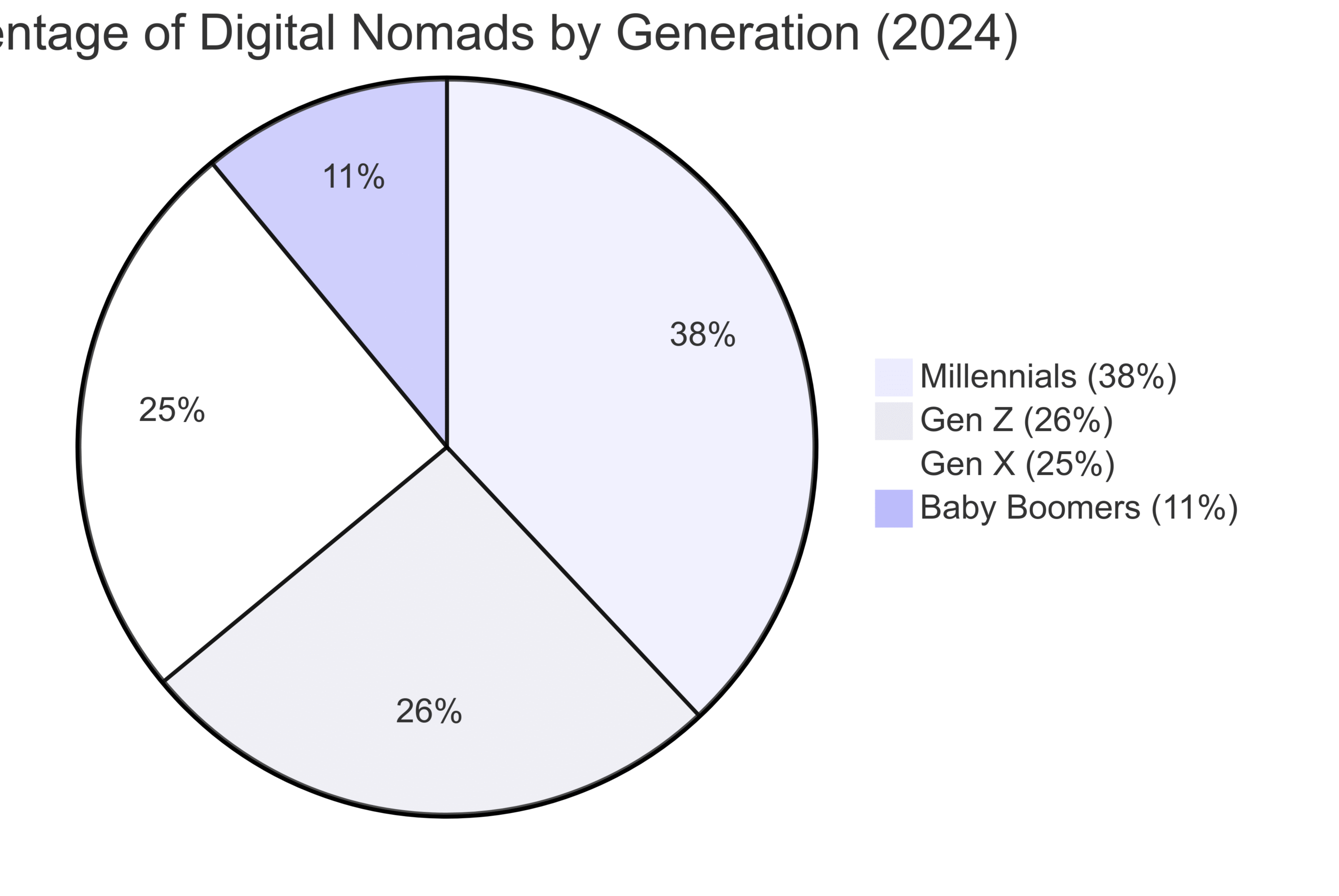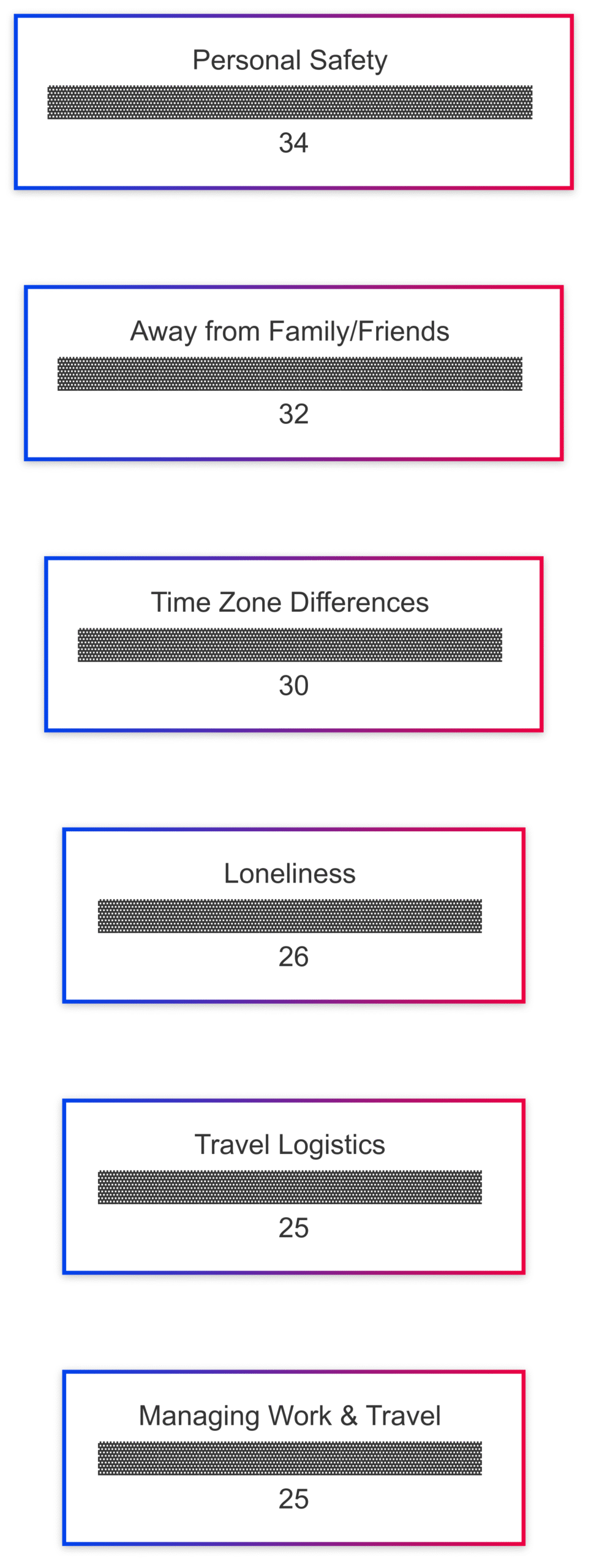Explore the rise of digital nomadism, its growth statistics, challenges, and top destinations. Discover why this lifestyle is reshaping work and travel globally.
Digital nomadism has transformed from a niche lifestyle into a global phenomenon, redefining how people work and live. Enabled by technology and fueled by a desire for freedom, flexibility, and adventure, digital nomads leverage remote work to explore new destinations while maintaining professional productivity. This comprehensive report delves into the growth of digital nomadism, its demographics, challenges, and evolving needs, supported by statistical insights and trends. Whether you’re a seasoned nomad or an aspiring one, this guide provides a detailed look at the movement reshaping the modern workplace.
What Is a Digital Nomad?
A digital nomad is an individual who uses technology to work remotely, embracing a location-independent lifestyle. This flexibility allows them to travel, immerse themselves in diverse cultures, and balance work with personal exploration. Digital nomads typically work in roles such as copywriting, data analysis, software development, graphic design, or consulting. They may be freelancers, full-time employees, contractors, or entrepreneurs, united by their ability to work from anywhere with a reliable internet connection.
The nomad lifestyle is defined by freedom and adaptability. Unlike traditional office-based work, digital nomads prioritize experiences, often moving between cities or countries while maintaining professional responsibilities. This lifestyle appeals to those seeking autonomy and a break from conventional 9-to-5 routines.
The Rise of Digital Nomadism: A Statistical Overview
Digital nomadism has seen exponential growth, particularly since the onset of the COVID-19 pandemic, which accelerated the shift to remote work. According to the MBO Partners’ 2024 State of Independence study, approximately 18.1 million American workers identify as digital nomads, representing 11% of the U.S. workforce. This marks a 147% increase from 2019, when 7.3 million Americans were digital nomads. Globally, an estimated 35 million people embrace this lifestyle, with the United States leading at 47% of the global nomad population.
Growth Trends
The growth trajectory of digital nomadism is remarkable:
- 2019: 7.3 million U.S. digital nomads.
- 2020: A 49% increase to 10.9 million, driven by pandemic-induced remote work policies.
- 2021: A 42% surge to 15.5 million, as more workers embraced location independence.
- 2022: Growth slowed to 9%, reaching 16.9 million.
- 2024: A 4.7% increase to 18.1 million, reflecting steady mainstream adoption.
The following table illustrates this growth:
| Year | Number of U.S. Digital Nomads (Millions) |
|---|---|
| 2018 | 4.8 |
| 2019 | 7.3 |
| 2020 | 10.9 |
| 2021 | 15.5 |
| 2022 | 16.9 |
| 2024 | 18.1 |
Source: MBO Partners, Statista
The pandemic catalyzed this growth by forcing companies to adopt remote work, enabling traditional employees to explore nomadic lifestyles. However, growth has stabilized as some employers implement return-to-office mandates, particularly affecting traditional workers. Meanwhile, independent nomads (freelancers and contractors) continue to grow, with a 20% increase in 2024 compared to a 14% rise in 2023.
Global Distribution
The United States dominates the digital nomad population, followed by other countries:
- United States: 47% (16.9 million in 2022, 18.1 million in 2024)
- United Kingdom: 7%
- Russia: 5%
- Canada and Germany: 4% each
- France: 3%
- Australia, Brazil, Netherlands: 2% each
Demographic Insights
Digital nomads skew younger, with Millennials (38%) and Gen Z (26%) comprising 64% of the population. However, older generations remain represented, with 25% Gen X and 11% Baby Boomers. Notably, 14% of nomads are 55 or older, reflecting broad appeal across age groups. Gender distribution is slightly male-dominated, with 59% male and 41% female nomads.
Digital nomads are highly educated, with 52% holding a college degree or higher (compared to 35% of adult Americans) and 18% possessing advanced degrees (versus 13% nationally). Their technical proficiency is evident, with 79% using AI in their work and 76% reporting advanced or intermediate AI skills, compared to 60% and 69% for non-nomads, respectively.
The following chart visualizes the generational breakdown of digital nomads:

Why Digital Nomadism Is Growing
Several factors drive the rise of digital nomadism:
- Remote Work Opportunities: The pandemic normalized remote work, with many companies adopting permanent flexible policies. This shift allowed traditional employees to explore nomadic lifestyles, with 66% of digital nomads in 2022 being traditional jobholders, up from 44% in 2019.
- Technological Advancements: High-speed internet, cloud-based tools, and collaboration platforms like Zoom and Slack enable seamless remote work. Digital nomads are early adopters, with 74% embracing new technologies compared to 42% of non-nomads.
- Cultural Shifts: Younger generations prioritize experiences over traditional career paths, valuing flexibility and adventure. The desire for work-life balance and autonomy fuels the nomad lifestyle.
- Geo-Arbitrage: Nomads often work from low-cost regions while earning higher wages from employers in developed countries, stretching their income further. For example, a nomad earning $75,000 annually in the U.S. can live comfortably in cities like Bangkok or Bali, where living costs are significantly lower.
- Corporate Policies: Many organizations now offer digital nomad programs, allowing employees to work remotely for extended periods. However, 14% of traditional nomads work without their employer’s knowledge, highlighting the need for formal policies.
Digital Nomad Communities: Building Global Connections
Digital nomads thrive in communities that foster collaboration and support. Platforms like Nomad List, WiFi Tribe, and LinkedIn provide spaces to connect, share resources, and network. Social media groups, such as the Global Digital Nomad Network on Facebook with 46,000 members, offer peer support and advice. These communities help nomads navigate challenges, from finding reliable Wi-Fi to securing affordable accommodations.
However, caution is advised, as some groups may harbor scammers. Thorough research and vetting are essential before engaging with new networks.
Challenges of the Digital Nomad Lifestyle
While appealing, the digital nomad lifestyle presents unique challenges:
Practical Challenges
- Reliable Wi-Fi: 52% of nomads struggle to find consistent internet, critical for remote work.
- Workspace Availability: 42% face difficulties securing suitable work environments.
- Time Zone Differences: 30% report challenges coordinating with colleagues across time zones.
- Travel Logistics: 25% cite managing travel plans as a hurdle.
- Personal Safety: 34% express concerns about safety in unfamiliar locations.
Emotional and Social Challenges
- Loneliness: 26% of nomads experience loneliness, with 24% struggling to unplug from work.
- Being Away from Family and Friends: 32% miss their loved ones.
- Overworking: 33% of self-employed nomads report overworking, impacting work-life balance.
- Career Progression: 25% worry about advancing their careers while nomadic.
Reasons for Discontinuation
Some nomads abandon the lifestyle due to:
- Fatigue from constant travel.
- High costs of frequent relocations.
- Difficulty balancing work and travel.
- Emotional strain from loneliness or missing loved ones.
The following chart outlines the top challenges faced by digital nomads:

Top Destinations for Digital Nomads
Digital nomads prioritize destinations offering affordability, reliable internet, and vibrant lifestyles. Key factors include cost of living, internet speed, and access to coworking spaces. Based on these criteria, top cities include:
- Bangkok, Thailand: Affordable living, fast internet (average 35 Mbps), and numerous coworking spaces.
- Delhi, India: Low costs, improving internet infrastructure, and a growing nomad community.
- Lisbon, Portugal: Affordable European hub with reliable Wi-Fi and a welcoming vibe.
- Chiang Mai, Thailand: Budget-friendly with a strong nomad community.
- Bali, Indonesia: Scenic beauty, affordable accommodations, and coworking hubs.
Top 10 Countries Visited by Digital Nomads
- United States
- Spain
- Thailand
- United Kingdom
- Germany
- Mexico
- France
- Italy
- Portugal
- Indonesia
London remains the most visited city, blending cultural richness with robust infrastructure. However, Barbados ranks as the least preferred destination due to high costs and limited nomad-friendly amenities.
Cost of Living in Top Nomad Cities
The following table compares monthly living costs (including rent, food, and transport) for a single nomad in top destinations:
| City | Monthly Cost (USD) | Avg. Internet Speed (Mbps) |
|---|---|---|
| Bangkok, Thailand | 800–1,200 | 35 |
| Delhi, India | 500–800 | 25 |
| Lisbon, Portugal | 1,200–1,800 | 50 |
| Chiang Mai, Thailand | 600–1,000 | 30 |
| Bali, Indonesia | 700–1,200 | 20 |
Source: Nomad List, Numbeo
The Impact of Digital Nomadism
Digital nomads are reshaping industries and economies:
- Hospitality: Co-living spaces and coworking hubs cater to nomads, offering flexible accommodations and workspaces.
- Technology: Demand for remote work tools has spurred innovations in collaboration software and cybersecurity.
- Local Economies: Nomads spend more than typical tourists, boosting local businesses and creating jobs.
- Workplace Policies: Companies are adopting nomad-friendly policies to attract talent, though regulatory challenges persist.
Countries are responding with digital nomad visas, with over 60 nations offering programs to attract remote workers. These visas simplify legal and tax compliance, encouraging longer stays.
Digital Nomad Income and Satisfaction
Digital nomad incomes vary widely due to the mix of full-time (64%) and part-time (36%) workers. Approximately 17% earn less than $25,000 annually, while 46% earn $75,000 or more, reflecting high demand for skills in fields like IT and consulting. Despite income disparities, 79% of nomads are satisfied with their earnings (41% very satisfied, 38% satisfied), compared to 67% of non-nomads.
Geo-arbitrage plays a significant role, allowing nomads to live in low-cost regions while earning competitive wages. This financial flexibility enhances satisfaction, with 79% of nomads reporting high job satisfaction and 81% expressing optimism about their career futures.
The Future of Digital Nomadism
Digital nomadism is poised for continued growth, driven by:
- Corporate Support: More companies are implementing nomad policies, reducing risks and enabling flexibility.
- Government Initiatives: Digital nomad visas and incentives attract remote workers to new destinations.
- Support Ecosystems: From coworking spaces to nomad villages, infrastructure is improving.
- Technological Advancements: Faster internet and AI-driven tools enhance remote work efficiency.
In 2024, 21 million Americans expressed definite interest in becoming digital nomads, with 45 million considering it. While only 7–9% of aspirants typically transition, this pool ensures sustained growth. The trend toward “slomading”—staying longer in fewer locations—reflects a shift toward sustainability, with nomads averaging 5.7 weeks per location in 2024.
Conclusion
Digital nomadism represents a seismic shift in how people approach work and life. With 18.1 million American nomads and 35 million globally, the lifestyle is no longer fringe but mainstream. Supported by technology, flexible work policies, and a growing support ecosystem, digital nomads are redefining productivity and freedom. Despite challenges like loneliness and logistical hurdles, the benefits of autonomy, adventure, and geo-arbitrage make this lifestyle appealing. Aspiring nomads can join vibrant communities, explore top destinations, and leverage resources to embark on a location-independent journey.
For more insights, download the full MBO Partners 2024 State of Independence report or visit platforms like Nomad List to start your nomad adventure.
FAQs
Who is a digital nomad?
A digital nomad uses technology to work remotely from any location, leading a location-independent lifestyle. They may be freelancers, employees, contractors, or entrepreneurs.
How has digital nomadism grown?
Digital nomadism has grown 147% in the U.S. since 2019, with 18.1 million nomads in 2024, driven by remote work and technological advancements.
What are the main challenges for digital nomads?
challenges include finding reliable Wi-Fi, managing travel logistics, loneliness, time zone differences, and balancing work with travel.
Please share this Statistical Report on Digital Nomadism Growth & Its Needs with your friends and do a comment below about your feedback.
We will meet you on next article.
Until you can read, What’s your best tips to manage your budget when travelling?
